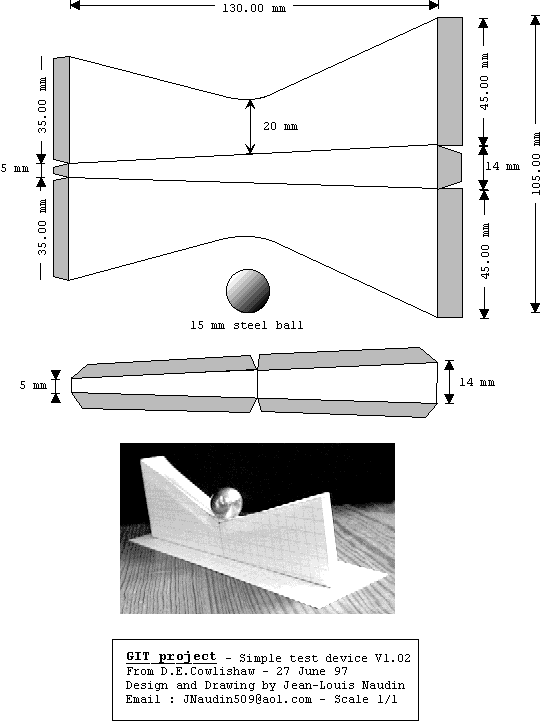

The basic GIT test
by Jean-louis Naudin
created on 04-09-98 - JLN Labs - Last update 05-30-98
The GIT (Gyroscopic Inertial Thruster) is a project from David Cowlishaw, this device convert kinetic energy from the translation into rotational energy. The main GIT project is the use of this effect for generating an unidirectional thrust by using hollow balls running around a circular ramp.
As far as I am concerned, today, I have only built and tested the linear J ramp version. I have used a simple cardboard and a steel ball, for this test.




click here to see the RealVideo of the experiment
( you need the RealPlayer V5.0 )
Notes :
I have built three models:
-the first one (V1.00) made with plywood. I have put antistrip
rubbers on the J ramp and used hollow ball.
-and two next models was made with a simple cardboard sheet (the
v1.01 and the v1.02), the latest (the v1.02) demonstrate clearly
the main effect claimed by David Cowlishaw. In all cases, it is
recommended to use an HOLLOW BALL.
The GIT is not a free (O/U) energy
device, this is an Inertial propulsion device,. The only fact
really noticed is that the major LINEAR KINETIC ENERGY IS
CONVERTED INTO ROTATIONAL ENERGY. This device consume energy but
generate a thrust like a propeler.
This is the main principle used in the rotating version of the
David Colishaw device. By this way a UNIDIRECTIONAL thrust can be
generated because in one way the centrifugal force is greater
than the centrifugal force in opposite way due to this linear
speed conversion.
This effect is observed in many others device like the Dean
drive, the Cook (CIP) drive, the Laskowith drive, the Nowlin
drive, the Matyas drive, the Cuff drive, the Thornson drive.....
The GIT drive is one of the many devices which prove that it is
possible to violate the principle of action/reaction....This is
not a free energy generator but an Inertial Thruster.
See also : The main Gyroscopic Inertial Thruster, the GIT V2.0, diagrams, pictures and video
If you need more informations or if you have any suggestions send me your Feedback
![]() Email
: [email protected]
Email
: [email protected]
Return to the Inertial propulsion main page